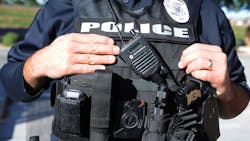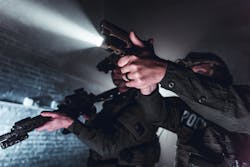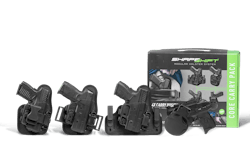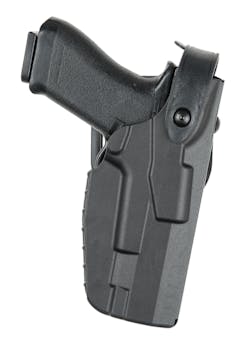By Steve Zalkin, President of the North American Association of Uniform Manufacturers and Distributors
There is no doubt that our lives are being transformed by the inclusion of technology and every year new trends are emerging that help us perform our activities more effectively and efficiently. Every profession is witnessing these changes technology is bringing, and one of the most interesting ways these changes are happening is in law enforcement duty gear.
For many, the assistance of state-of-the-art, cutting-edge gear is one of the best perks of joining and being in law enforcement. Let us look at some of the ways that innovative duty gadgetry is helping officers carry out their jobs better and keeping everyone safe while doing so.
1 Weapon-mounted lights
The law enforcement profession can be very unpredictable as the working environment can change at any moment. In one shift, a police officer can experience anything from a well-lit office, to an empty, abandoned warehouse or the proverbial dark alley. Thankfully, the flashlight allows the officer to see in these conditions and it has become almost as common as the gun and the badge.
However, what hasn’t been common but is gradually becoming the norm is the combination of gun and light—weapon-mounted lights!Mounted lights on weapons have provided a supplement to the flashlight and duty pistol, which can be cumbersome for the gun handler. Weapon-mounted lights were initially used for service-size pistols only, but as the technological revolution shrunk the size of tactical lights, with increased output in the light intensity, this has made it possible for lights to be mounted on compact and subcompact guns worn in concealment.
Of all the attributes that lights on weapons have, the greatest is the sturdiness it provides with two-handed pistol grips for law enforcement officers who grapple with the discomfort of holding a torch on one hand and your gun on the other.
Two companies that provide a wide range of long gun and pistol lights are Streamlight and Surefire. While Surefire is, in many ways, the industry leader in lights, Streamlight is an excellent company that offers less-expensive products. Both companies invest significantly in new technologies.
2 Holsters
Officers are always buying new off-duty firearms, and it is necessary for them to buy a concealed carry holster alongside and manufacturers are always ready to oblige. Many companies like Aker Leather, Boston Leather, Gould & Goodrich, Strong Leather and Safariland, to name a few, have become popular for their holsters. However, while every cop has their favorite brand and holster model, buying a new holster yearly could lead to the problem of having too many of them in the holster drawer. Enter ShapeShift Modular Holster System from Alien Gear which is pioneering a shape-shifting holster technology.
Any officer who has worn a holster knows the importance of adapting it to mold to their body. Even for holsters of the same brand and style, a new holster for a new gun will still require some time breaking into.The ShapeShift Carry Pack has in it parts that allow for customization of firearms and how they are being carried. It is a family of breathable neoprene holster “bases,” which include waistband (IWB), appendix carry, outside waistband belt slide and OWB paddle, as well as dozens of holster shells specific to a firearm. Select left- or right-hand draw and one or more firearms to get started. After breaking into a base to your liking, swapping a shell for another only takes less than a minute.
Gould and Goodrich produces a wide range of low-profile concealment holsters. Many are ambidextrous and can carry multiple size weapons.
3 Holster accessories
Holster accessories impact gear functionality in the same way. A new backup pouch from DeSantis includes a removable paddle that allows the pouch to be used as a belt holster. This backup pouch can hold different kinds of firearms, which include most 9mm or .40 S&W double-stacked magazines, which have room for most small flashlights with a one-inch diameter.
There is also the Champ holster from DeSantis, which has a versatile design that makes it easy for users to switch easily from right-hand draw to left-hand draw just by moving one screw. This kind of durable holster gives the confidence that if a struggle was to ensue with someone who is trying to reach for your gun, there is a high chance it will remain intact.Safariland, another popular manufacturer, is producing a series of holsters that have been engineered to provide a different form of protection. Their Model 7360 7TS ALS/SLS Mid-Ride Level III Retention Duty Holster comes with an automatic locking system that is part of a Self Locking System or SLS. Having holstered your firearm, it automatically locks in every direction or area. It may be operated merely by the use of a thumb, and it is easy to take the duty weapon out of the holster in just one swift movement.
To add to that, Safariland has also developed an auto camera activation system that links the holster with the body camera, activating it upon the officer’s draw. This innovative technology allows the body camera to be activated automatically without any necessary motion and additional maneuvering required. This provides a safe firearm draw, especially in high-pressure situations.
4 Tactical medical gear integrated into uniforms
Tourniquets being integrated into shirtsleeves and pant legs are not new, although they can be pretty expensive, and cumbersome to wear and may not be as effective as standalone tourniquets. Manufacturers are developing pockets and pouches on officer uniforms that can hold Narcan and other medical items as they are developed.
The needs for this kind of integration cannot be overemphasized. Today, officers are beginning to wear tourniquets, Epi-Pens, and anti-opiate pens on their belts. This used to be a thing for fire and medic services in the past. The police are often the first to arrive at a scene and render immediate assistance before the arrival of emergency services, so it makes sense that this component is added to officer uniforms as well.
5 Body cameras
Not all body cameras are created equal. Perhaps most importantly, policies and technology must be designed to ensure that police cannot “edit on the fly”—i.e., choose which encounters to record with limitless discretion. If police are free to turn the cameras on and off as they please, the cameras’ role in providing a check and balance against police power will shrink and they will no longer become a net benefit.
Past research has shown the use of body cameras can improve the behavior of both police officers and community members during encounters, compared with non-body camera conditions (Jennings, Lynch, and Fridell 2015). This “civilizing effect” has been connected to decreases in officer use of force, complaints against officers, and resistance during arrests (White 2014). The video recordings have been used to improve evidence for arrest and prosecution, to disprove and substantiate allegations made against the police, and to help expedite the resolution of complaints (Goodall 2007; Harris 2010).
Conclusion
The 21st century is seeing a rapid evolution of law enforcement which has seen police officers exposed to modern threats, added to increasing public and media scrutiny. Law enforcement is responding with significant changes in gear tech that help to make policing better and more efficient.
It is necessary, however, to understand the pros and cons of these new technological changes so that you can make informed recommendations on what to invest in.
Keep in mind that new trends ensure law enforcement can stay ahead of the bad guys and prevent more crime from happening.
About the Author
Steve Zalkin is a uniform industry veteran and former distributor of uniforms. Currently, he is president of the North American Association of Uniform Manufacturers and Distributors. To learn more about the RFP process, contact Steve at [email protected].






